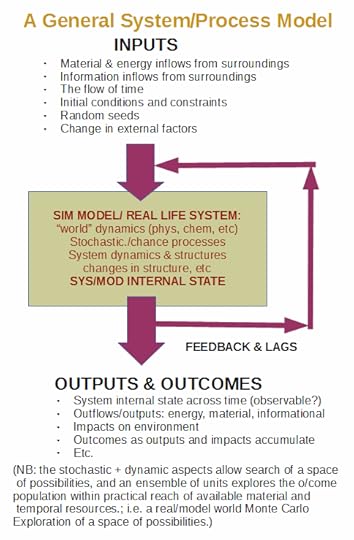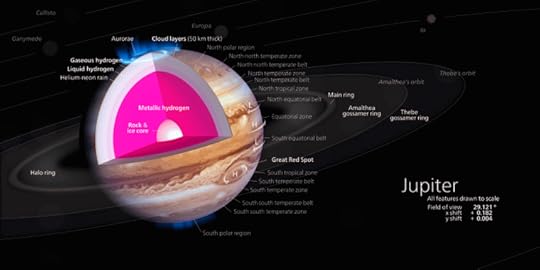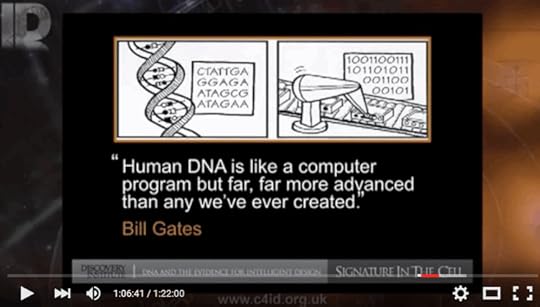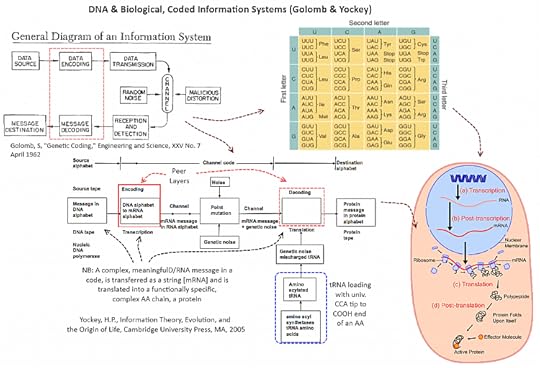Michael J. Behe's Blog, page 559
December 7, 2018
Did a researcher create a cyborg plant?
 Is the following really a plant-machine hybrid?:
Is the following really a plant-machine hybrid?:
If plants could move around freely, they would move into the most beneficial lighting arrangement. They compensate for their rootedness by growing in the optimum direction and constantly repositioning their leaves.
An MIT researcher has helped out a plant by fitting it with electronic sensors attached to robotic wheels. The sensors detect the electrical signals the plant emits when it detects light and convey these signals to a motor that moves the wheels to a more light-friendly location. News, “That plant is not a cyborg” at Mind Matters
Or are we “planting” a mistaken idea?
See also: Can plants be as smart as animals? Seeking to thrive and grow, plants communicate extensively, without a mind or a brain
and
Can a stuffed toy turn into a robot? Maybe to amuse a sick child? With the right skin, yes.
Copyright © 2018 Uncommon Descent . This Feed is for personal non-commercial use only. If you are not reading this material in your news aggregator, the site you are looking at is guilty of copyright infringement UNLESS EXPLICIT PERMISSION OTHERWISE HAS BEEN GIVEN. Please contact legal@uncommondescent.com so we can take legal action immediately.
Plugin by Taragana
Theoretical physicist: Contrary to hype, a larger collider will probably not answer the Big Questions

Big Bang/NASA
Sabine Hossenfelder, author of Lost in Math: How Beauty Leads Physics Astray, is not enthusiastic about a new video promoting a new, larger collider for CERN. She believes that current, serious problems are being smoothed over for politicians and the public, by general soothing noises that a bigger collider might answer many questions about our universe. Her summaries are worth reading in detail, for example,
Why is there no more antimatter?
Because if there was, you wouldn’t be here to ask the question. Presumably this item refers to the baryon asymmetry. This is a fine-tuning problem which simply may not have an answer. And even if it has, the FCC may not answer it.
In general, she thinks,
That particle physicists can fumble together models that predict all and everything is why I no longer trust their predictions. Again, it’s not impossible the FCC would find something, but there is no good reason for why that should happen.
…
I am not opposed to building a larger collider. Particle colliders that reach higher energies than we probed before are the cleanest and most reliable way to search for new physics. But I am strongly opposed to misleading the public about the prospects of such costly experiments. We presently have no reliable prediction for new physics at any energy below the Planck energy. A next larger collider may find nothing new. That may be depressing, but it’s true. Sabine Hossenfelder, “CERN produces marketing video for new collider and it’s full of lies” at BackRe(Action)
Here’s the vid:
Some may wince at Hossenfelder referring to the PR as “full of lies.” but the fact is, many of these science marketers are probably desperate. Terms like “crisis,” “stagnation,” and “post-empirical” have become commonplace in describing the current state of theoretical physics. One response is to just keep the hype going.
Hype analysis is hairsplitting. Eventually, silence must fall, one supposes, and perhaps it will be possible to talk honestly about the underlying assumptions.
See also: Rob Sheldon on the physics wars: Stagnation or no?
Theoretical physicist: My field is not going to the dogs
Theoretical physicist: Present phase of physics “not normal” – stagnation, not crisis
Is cosmology in crisis over how to measure the universe?
and
“Perhaps physics has slipped into a post-empirical era”
Copyright © 2018 Uncommon Descent . This Feed is for personal non-commercial use only. If you are not reading this material in your news aggregator, the site you are looking at is guilty of copyright infringement UNLESS EXPLICIT PERMISSION OTHERWISE HAS BEEN GIVEN. Please contact legal@uncommondescent.com so we can take legal action immediately.
Plugin by Taragana
Young aphids, fleeing munching cows, hitch rides on adults

Pea aphids (Acyrthosiphon pisum)/Shipher Wu, Gee-way Lin, National Taiwan University (CC BY 2.5)
When pea aphids (Acyrthosiphon pisum) are fleeing a browsing cow, the tiny ones try to ride the much larger ones to safety:
In a lab setup, hitchhiking got very young aphids safely across open ground about four times faster than scrabbling to safety on their own, the researchers found. These newborn aphids, not even 12 hours old, were not just seeking some object to clamber onto. They soon lost interest if presented with beads or dead adults but held on to live grown-up aphids in motion, the researchers report December 6 in Frontiers in Zoology.Susan Milius, “Pea aphid youngsters use piggyback rides to escape a crisis” at ScienceNews
Only some adults would let them ride (5% succeeded) and kinship didn’t apparently matter (sorry, Darwinian kin selectionists; this time, it’s any old port in a storm).
At any rate, even insect minds, so to speak, are more complex than we used to think.
Abstract: Background: Upon the detection of imminent peril, pea aphids (Acyrthosiphon pisum) often drop off their host plant. Dropping in response to insect enemies is intermittent in nature, but when a mammalian herbivore feeds on their host plant, a large mixed-age group of aphids usually drops off the plant at once. Aphids that reach the ground are confronted with new, hostile environmental conditions and must therefore quickly walk toward a suitable host plant. The longer it takes an aphid to reach a host plant, the more it is exposed to the risks of starvation, desiccation and predation.
Results: We found that young nymphs, which have limited mobility and high mortality on the ground, quickly climb on conspecific (not necessarily parental) adults and cling to them before the latter start walking in search of a plant. This “riding” behavior is likely to be adaptive for the nymphs, for it shortens their journey and the time they spend off a host plant. Adults however, seem to be irritated by the riding nymphs, as they often actively try to remove them.
Conclusions: After dropping from the host plant, young aphid nymphs travel at least part of the way back to a plant on the backs of adults. For the riding behavior to take place, nymphs need to successfully find adults and withstand removal attempts.(open access) Standing on the shoulders of giants: young aphids piggyback on adults when searching for a host plant Moshe Gish and Moshe Inbar Frontiers in Zoology201815:49 https://doi.org/10.1186/s12983-018-02...© The Author(s). 2018 Received: 27 May 2018 Accepted: 5 November 2018Published: 6 December 2018 More.
Follow UD News at Twitter!
See also: J. Scott Turner and the “Giant Crawling Brain”
and
Sublime Mold Does Intelligence Always Reside in the Brain? Maybe Not!
Copyright © 2018 Uncommon Descent . This Feed is for personal non-commercial use only. If you are not reading this material in your news aggregator, the site you are looking at is guilty of copyright infringement UNLESS EXPLICIT PERMISSION OTHERWISE HAS BEEN GIVEN. Please contact legal@uncommondescent.com so we can take legal action immediately.
Plugin by Taragana
Researcher: Teeth are an “astonishing” source of information

Neanderthal/Photaro
Reflections on a recent study of Neanderthal children’s teeth and one other (5000 ya):
Teeth are a really useful indicator of past environments.
This is possible because teeth have biological rhythms, and key events get locked inside them. These faithful internal clocks run night and day, year after year, and include daily growth lines and a marked line formed at birth.
…
Previously, my colleagues and I discovered that an 8-year-old Belgian Neanderthal was weaned at 1.2 years of age. This probably was atypical, as the nursing signal dropped off rapidly and the individual showed stress in its first molar at this exact time.
We’re not sure if this means that it was separated from its mother or just really sick—but it’s likely that Neanderthal kids nursed for longer when they could.
Our new approach allows scientists to flesh out the lives of ancient children with unprecedented detail, including fine-scaled views of life in Ice Age Europe, through the remarkable tales their teeth tell.The Conversation Tanya M. Smith, “Secrets Hidden in Ancient Teeth” at Sapiens
Teeth and soft tissue seem to be turning ideology into history, especially where our ancestors are concerned. Notice that the speculation is much more focused on everyday reality and much less on “the evolution of sexual jealousy” or some similar malarkey. And all the better for that!
Follow UD News at Twitter!
See also: Researchers: Soft tissue shows Jurassic ichthyosaur was warm-blooded, had blubber Soft tissue analysis seems to have brought oddities to life. Although considered a reptile, the ichthyosaur had features that remind one of a mammal.
and
Was Neanderthal man fully human? The role racism played in assessing the evidence
Copyright © 2018 Uncommon Descent . This Feed is for personal non-commercial use only. If you are not reading this material in your news aggregator, the site you are looking at is guilty of copyright infringement UNLESS EXPLICIT PERMISSION OTHERWISE HAS BEEN GIVEN. Please contact legal@uncommondescent.com so we can take legal action immediately.
Plugin by Taragana
Dark matter detection claim takes a hit
COSINE-100’s sodium-iodide detector array/Chang Hyon Ha
From ScienceDaily:
Astrophysical evidence suggests that the universe contains a large amount of non-luminous dark matter, yet no definite signal of it has been observed despite concerted efforts by many experimental groups. One exception to this is the long-debated claim by the DArk MAtter (DAMA) collaboration, which has reported positive observations of dark matter in its sodium-iodide detector array.
The new COSINE-100 experiment, based at an underground, dark-matter detector at the Yangyang Underground Laboratory in South Korea, has begun to explore DAMA’s claim. It is the first experiment sensitive enough to test DAMA and use the same target material of sodium iodide.
COSINE-100 has been recording data since 2016 and now has initial results that challenge the DAMA findings. Those findings are published online this week in the journal Nature.
And what happened?
“The initial results carve out a fair portion of the possible dark matter search region drawn by the DAMA signal. In other words, there is little room left for this claim to be from the dark matter interaction unless the dark matter model is significantly modified,” said Hyun Su Lee, the other co-spokesperson for COSINE-100, and an associate director of the Center for Underground Physics at IBS. Paper. (paywall) – From Yale University, based on he COSINE-100 Collaboration. An experiment to search for dark-matter interactions using sodium iodide detectors. Nature, 2018 DOI: 10.1038/s41586-018-0739-1 More.
The researchers are 90% confident they have ruled dark matter out:
The COSINE-100 team will now work on determining whether its detectors observe a seasonal cycle of nonbackground detections. Due to the sensitivity of the crystals and an unexpected shortfall in detector performance, that probably requires about three more years of data collection. But other NaI-based experiments are on the case, and COSINE-100 may share data with one of them, ANAIS in the Spanish Pyrenees, to speed up the process. With further progress on the NaI front, researchers may finally be able to peg DAMA’s signal to instrument error, an overlooked atmospheric or cosmic interloper, or a more exotic variety of dark-matter particle. (COSINE-100 collaboration, Nature 564, 83, 2018.) Andrew Grant, “Long-standing dark-matter detection claim takes a hit” at Physics Today
Frustrating but better to know.
See also: Discover: Even the best dark matter theories are crumbling
Researcher: The search for dark matter has become a “quagmire of confirmation bias” So many research areas in science today are hitting hard barriers that it is reasonable to think that we are missing something.
Physicists devise test to find out if dark matter really exists
Follow UD News at Twitter!
Largest particle detector draws a blank on dark matter
What if dark matter just doesn’t stick to the rules?
A proposed dark matter solution makes gravity an illusion
and
Proposed dark matter solution: “Gravity is not a fundamental governance of our universe, but a reaction to the makeup of a given environment.”
Copyright © 2018 Uncommon Descent . This Feed is for personal non-commercial use only. If you are not reading this material in your news aggregator, the site you are looking at is guilty of copyright infringement UNLESS EXPLICIT PERMISSION OTHERWISE HAS BEEN GIVEN. Please contact legal@uncommondescent.com so we can take legal action immediately.
Plugin by Taragana
Logic & First Principles, 3: The roots of right reason and the power/limits of entailment
Why is this topic important? (Why a series, now on no 3 (see 1 and 2)?)
Here at UD, the phrase “first principles of right reason” and similar ones (e.g. “reason’s rules”) have often come up. Others talk about “the laws of thought,” which in a post-Kant world hints of “the ugly gulch” between the inner world of mental, conscious phenomena and the outer world of things in themselves. In that context, we have often highlighted that evolutionary materialistic scientism is irretrievably self-referentially incoherent and have pointed out how this means it is necessarily false. We have also pointed to “self-evident” first truths and principles, including the principle of distinct identity and its immediate corollaries, non-contradiction and the excluded middle. There has even been a cross-connection to numbers and the core of Mathematics, understood as the [study of the] logic of structure and quantity.
All of this points to how central issues of rational, responsible thought and how this credibly accesses and gives us significantly true and well-founded knowledge about reality are. Yes, to the vexed, ongoing debates over ID. Yes, too, to the wider issue of defending rationality and responsibility (note, not rational-ISM) in our civilisation.
For, believe it or not, responsible rational freedom and our ability to credibly warrant knowledge about reality are under serious attack in our civilisation.
Exhibit A, let’s highlight and mark up Alex Rosenberg as he begins Ch 9 of his The Atheist’s Guide to Reality:
FOR SOLID EVOLUTIONARY REASONS, WE’VE BEEN tricked into looking at life from the inside. Without scientism, we look at life from the inside, from the first-person POV (OMG, you don’t know what a POV is?—a “point of view”). The first person is the subject, the audience, the viewer of subjective experience, the self in the mind.
Scientism shows that the first-person POV is an illusion. [–> grand delusion is let loose in utter self referential incoherence] Even after scientism convinces us, we’ll continue to stick with the first person. But at least we’ll know that it’s another illusion of introspection and we’ll stop taking it seriously. We’ll give up all the answers to the persistent questions about free will, the self, the soul, and the meaning of life that the illusion generates [–> bye bye to responsible, rational freedom on these presuppositions].
The physical facts fix all the facts. [–> asserts materialism, leading to . . . ] The mind is the brain. It has to be physical and it can’t be anything else, since thinking, feeling, and perceiving are physical process—in particular, input/output processes—going on in the brain. We [–> at this point, what “we,” apart from “we delusions”?] can be sure of a great deal about how the brain works because the physical facts fix all the facts about the brain. The fact that the mind is the brain guarantees that there is no free will. It rules out any purposes or designs organizing our actions or our lives [–> thus rational thought and responsible freedom]. It excludes the very possibility of enduring persons, selves, or souls that exist after death or for that matter while we live.
Exhibit B, Sir Francis Crick — yes, that Crick — in his 1994 The Astonishing Hypothesis:
. . . that “You”, your joys and your sorrows, your memories and your ambitions, your sense of personal identity and free will, are in fact no more than the behaviour of a vast assembly of nerve cells and their associated molecules. As Lewis Carroll’s Alice might have phrased: “You’re nothing but a pack of neurons.” This hypothesis is so alien to the ideas of most people today that it can truly be called astonishing.
Of course, just a year later, Philip Johnson replied that Sir Francis should have therefore been willing to preface his works thusly: “I, Francis Crick, my opinions and my science, and even the thoughts expressed in this book, consist of nothing more than the behavior of a vast assembly of nerve cells and their associated molecules.” Johnson then acidly commented: “[t]he plausibility of materialistic determinism requires that an implicit exception be made for the theorist.” [Reason in the Balance, 1995.]
Exhibit C, J B S Haldane’s longstanding warning from 1932:
“It seems to me immensely unlikely that mind is a mere by-product of matter. For if my mental processes are determined wholly by the motions of atoms in my brain I have no reason to suppose that my beliefs are true. They may be sound chemically, but that does not make them sound logically. And hence I have no reason for supposing my brain to be composed of atoms. In order to escape from this necessity of sawing away the branch on which I am sitting, so to speak, I am compelled to believe that mind is not wholly conditioned by matter.” [“When I am dead,” in Possible Worlds: And Other Essays [1927], Chatto and Windus: London, 1932, reprint, p.209. (NB: DI Fellow, Nancy Pearcey brings this right up to date (HT: ENV) in a current book, Finding Truth.)]
How can we reply effectively?
For one, by documenting the fact as we just saw; this cannot responsibly be denied.
Next, we must point out that a material, GIGO-constrained computational substrate is utterly incapable of responsible, rational freedom. For, such a substrate only acts on mechanical necessity multiplied by equally blind chance, forming a dynamic-stochastic entity illustrated by:
That is, it is indeed incapable of the morally governed freedom to reason, infer and conclude beyond whatever bugs lie in its programs and architecture, driven by underlying mechanical necessity and/or chance. Yes, garbage in does not credibly lead to gospel out. Self-referential incoherence and delusion follow.
(But then, if one is wedded to Rosenbergian materialistic irrationality one will not take such seriously. A warning sign. And, if you disagree but are at least a fellow traveller on the evo mat scientism train, you owe us a substantial explanation as to why Crick-Haldane-Rosenberg collapse does not follow: _______ [And yes, that’s another pesky UD fill-in-the-blank please challenge.])
To save a long preliminary side-bar, let’s put up an alternative that gives us room to form a different concept, the Derek Smith Model for two-tier controller cybernetic loop entities, observing how there is a higher order supervisory controller that influences the lower and shares processing and memory resources:
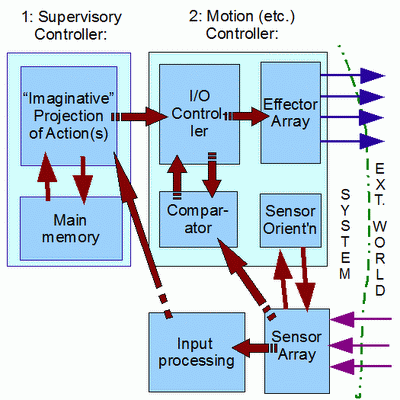
The Derek Smith two-tier controller cybernetic model
In more detail, from Smith himself:
Let’s just suggest that at quantum level, plausibly influences may affect actualised outcomes. Perhaps, roughly analogous to how observer action is known to affect outcomes (and without inviting yet another side-debate. Let me just quote Scot Calef:
Keith Campbell writes, “The indeterminacy of quantum laws means that any one of a range of outcomes of atomic events in the brain is equally compatible with known physical laws. And differences on the quantum scale can accumulate into very great differences in overall brain condition. So there is some room for spiritual activity even within the limits set by physical law. There could be, without violation of physical law, a general spiritual constraint upon what occurs inside the head.” (p.54). Mind could act upon physical processes by “affecting their course but not breaking in upon them.” (p.54). If this is true, the dualist could maintain the conservation principle but deny a fluctuation in energy because the mind serves to “guide” or control neural events by choosing one set of quantum outcomes rather than another. Further, it should be remembered that the conservation of energy is designed around material interaction; it is mute on how mind might interact with matter. After all, a Cartesian rationalist might insist, if God exists we surely wouldn’t say that He couldn’t do miracles just because that would violate the first law of thermodynamics, would we? [Article, “Dualism and Mind,” Internet Encyclopedia of Philosophy.]
And, let us note from SEP on Consciousness, discussing Hameroff and Penrose:
It is argued that elementary acts of consciousness are non-algorithmic, i.e., non-computable, and they are neurophysiologically realized as gravitation-induced reductions of coherent superposition states in microtubuli . . . . Penrose’s rationale for invoking state reduction is not that the corresponding randomness offers room for mental causation to become efficacious (although this is not excluded). His conceptual starting point, at length developed in two books (Penrose 1989, 1994), is that elementary conscious acts must be non-algorithmic. Phrased differently, the emergence of a conscious act is a process which cannot be described algorithmically, hence cannot be computed. His background in this respect has a lot to do with the nature of creativity, mathematical insight, Gödel’s incompleteness theorem, and the idea of a Platonic reality beyond mind and matter . . . . With his background as an anaesthesiologist, Hameroff suggested to consider microtubules as an option for where reductions of quantum states can take place in an effective way, see e.g., Hameroff and Penrose (1996). The respective quantum states are assumed to be coherent superpositions of tubulin states, ultimately extending over many neurons. Their simultaneous gravitation-induced collapse is interpreted as an individual elementary act of consciousness. The proposed mechanism by which such superpositions are established includes a number of involved details that remain to be confirmed or disproven.
All of this is to allow us to take our responsibly and rationally free, self-aware, self-moved conscious inner life sufficiently seriously to engage the questions of logic that are our primary focus. That is how far gone our civilisation is.
We also need to take the Kantian ugly gulch off the table, by way of yet another pointing out of self-referential incoherence. F H Bradley, in Appearance and Reality:
We may agree, perhaps, to understand by metaphysics an attempt to know reality as against mere appearance, or the study of first principles or ultimate truths, or again the effort to comprehend the universe, not simply piecemeal or by fragments, but somehow as a whole [–> i.e. the focus of Metaphysics is critical studies of worldviews] . . . .
The man who is ready to prove that metaphysical knowledge is wholly impossible . . . himself has, perhaps unknowingly, entered the arena . . . To say the reality is such that our knowledge cannot reach it, is a claim to know reality ; to urge that our knowledge is of a kind which must fail to transcend appearance, itself implies that transcendence. For, if we had no idea of a beyond, we should assuredly not know how to talk about failure or success. And the test, by which we distinguish them, must obviously be some acquaintance with the nature of the goal. Nay, the would-be sceptic, who presses on us the contradictions of our thoughts, himself asserts dogmatically. For these contradictions might be ultimate and absolute truth, if the nature of the reality were not known to be otherwise . . . [such] objections . . . are themselves, however unwillingly, metaphysical views, and . . . a little acquaintance with the subject commonly serves to dispel [them]. [Appearance and Reality, 2nd Edn, 1897 (1916 printing), pp. 1 – 2; INTRODUCTION. At Web Archive.]
So, we are free to look at the key first principles of right reason. A diagram will help:
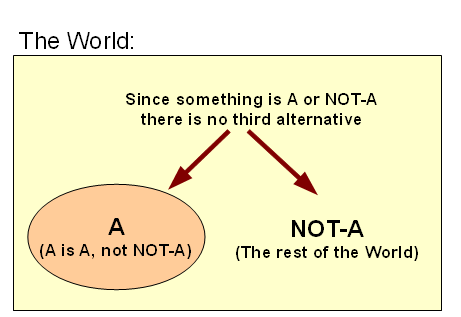
Laws of logic in action as glorified common-sense first principles of right reason
Let’s suggest for concreteness, that A might be a bright red ball on a table:
. . . or hanging in the sky:
A cutaway view of Jupiter, showing the expected metallic hydrogen “shell” {in Pink), held to be a key factor in its magnetic field [HT: Wikipedia]
Clearly, such an A is part of the world W, and is distinct from the rest, ~A:W = {A|~A} . . . Law of [Distinct] Identity, LOI.
Now, ponder some x in W, i/l/o the partition shown by the pipe character:
No x in W can be A AND ~A, Law of Non-Contradiction [LNC].
Any x in W is A X-OR ~A, Law of the Excluded Middle [LEM].
LOI, being fundamental, needs to be expanded:
A is itself i/l/o its core characteristics (that give it distinction from whatever is ~A).
So, too, if two candidate entities x and y have no critical distinguishing characteristics, they are the same entity. The evening and the morning star are the same entity as the planet Venus. Likewise A distinct from ~A shows how two-ness is framework to any possible world, brings with it the system of numbers thus operations on them and so also the core of Mathematics. Mathematics in key part is at the core of reality. An inherently abstract system.
We must use distinct identity just to string symbols together to communicate, to think and to do Mathematics or Science. For example, as the Apostle Paul long since noted in writing to the Corinthians:
1 Cor 14:7 If even inanimate musical instruments, such as the flute or the harp, do not give distinct notes, how will anyone [listening] know or understand what is played? 8 And if the war bugle gives an uncertain (indistinct) call, who will prepare for battle?
9 Just so it is with you; if you in the [unknown] tongue speak words that are not intelligible, how will anyone understand what you are saying? For you will be talking into empty space!
10 There are, I suppose, all these many [to us unknown] tongues in the world [somewhere], and none is destitute of [its own power of] expression and meaning. 11 But if I do not know the force and significance of the speech (language), I shall seem to be a foreigner to the one who speaks [to me], and the speaker who addresses [me] will seem a foreigner to me. [AMP]
Language is key to rational intelligence, and is a key sign of it. Which of course points to the significance of the DNA code:
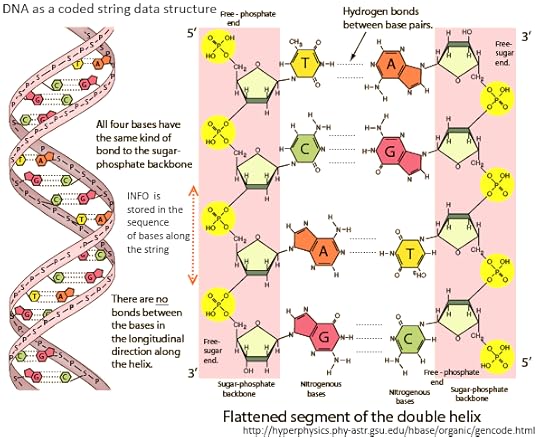
DNA is a string digital data structure which stores coded information in the specific sequence of bases, G/C/A/T, both for protein coding and for regulation/control
So also, we see how coded algorithms are central to protein synthesis, thus to cell based life:

Protein Synthesis (HT: Wiki Media)
No wonder, Crick observed in a letter to his son Michael on March 19th 1953 written to explain the discovery of the DNA double-helix:

Crick’s letter
And later, Bill Gates aptly observed:
Hubert Yockey looked at the wider communication system,
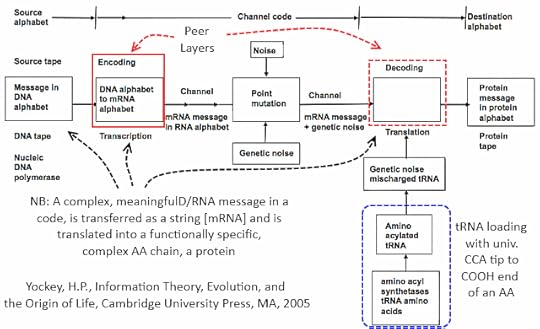
Yockey’s analysis of protein synthesis as a code-based communication process
. . . bringing to bear:
In short, we here recognise cases of alphanumeric code, thus language, functioning in a communication system and expressing step by step finite goal-oriented processes, i.e. algorithms. Such characteristics are manifest signs of intelligence at work.
We have of course already brought out how LNC and LEM are immediate corollaries of LOI, but it is worth mentioning such again.
Moreover, as distinct identity is not just a verbal label, it speaks to the logic of being, i.e. we see another bridge to the empirical and abstract worlds, which allows us to see how things may or may not be:
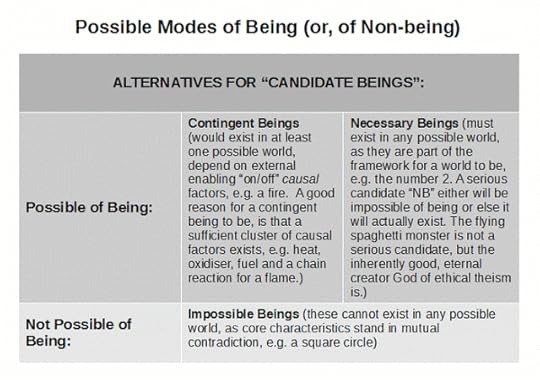 This already shows us how we can at least inquire about anything that is or is not, or may be, or is impossible of being, as to why such is the case. That sets up the weak form principle of sufficient reason and the linked principles of cause and effect. Again, POI pervades the matter.
This already shows us how we can at least inquire about anything that is or is not, or may be, or is impossible of being, as to why such is the case. That sets up the weak form principle of sufficient reason and the linked principles of cause and effect. Again, POI pervades the matter.
Where also, we saw in 1 and 2 how inductive reasoning — argument by support rather than entailment — also pivots on POI.
POI is truly fundamental, logically and ontologically, so also LNC and LEM.
From these, we note how the logic of entailment essentially demonstrates (on whatever reason) why if premises p1, p2, . . . pn obtain, consequences c1, c2 . . . cm must follow by force of logical sufficiency; this is validity. So too, if the premises are true — accurately describing reality — the conclusions will also be true; we have a sound argument.
A consequence is, that p => q can be reversed, ~q => ~p so such arguments pivot on which premises are to be accepted and what consequences and comparative difficulties obtain for q and ~q.
Where, lastly, to assert p AND ~p => [anything], blowing up the system through the principle of explosion. That absurdity leads to the force of the point that to hold a contradiction is to hold a necessary falsity and to the basis of reduction to absurdity as a means of accepting the credibility of truly framework first principles.
In the case where absurdity is instantly evident to the understanding eye, we speak of self-evidence.
So, we see the outlines of logic and its power emerging. END
Copyright © 2018 Uncommon Descent . This Feed is for personal non-commercial use only. If you are not reading this material in your news aggregator, the site you are looking at is guilty of copyright infringement UNLESS EXPLICIT PERMISSION OTHERWISE HAS BEEN GIVEN. Please contact legal@uncommondescent.com so we can take legal action immediately.
Plugin by Taragana
December 6, 2018
Whether or not man has free will, quantum mechanics means that nature does
 Computer engineering prof Robert J. Marks, first author of Introduction to Evolutionary Informatics, explains,
Computer engineering prof Robert J. Marks, first author of Introduction to Evolutionary Informatics, explains,
When I was boy, my father explained free will and predestination to me:
I dig a fence post hole.
· Did I create the hole because of my own free will?
· Or was the hole already there and I simply removed the dirt? If true, the hole was predestined.
The question cannot be answered by examining the evidence. In philosophy terms, it is “empirically unanswerable.” That is the sort of stuff that philosophers debate. Religious people might point to scripture to support one conclusion over the other.
In physics, however, quantum randomness offers a definitive answer to the question of predestination vs. free will—for subatomic particles. Robert J.Marks, “Quantum Randomness Gives Nature Free Will” at Mind Matters More.
Dr. Marks goes on to explain why quantum mechanics can provide effective cryptography.
Follow UD News at Twitter!
See also: Also: byRobert J. Marks: Human Consciousness May Not Be Computable One model of consciousness would mean that conscious computers are a physical impossibility
and
AI that can read minds? Deconstructing AI hype
See also: Do quasars provide evidence for free will?
Copyright © 2018 Uncommon Descent . This Feed is for personal non-commercial use only. If you are not reading this material in your news aggregator, the site you are looking at is guilty of copyright infringement UNLESS EXPLICIT PERMISSION OTHERWISE HAS BEEN GIVEN. Please contact legal@uncommondescent.com so we can take legal action immediately.
Plugin by Taragana
Researchers: Soft tissue shows Jurassic ichthyosaur was warm-blooded, had blubber
180-million-year-old ichthyosaur featuring soft tissue/Johan Lindgren
From ScienceDaily:
Molecular and microstructural analysis of a Stenopterygius ichthyosaur from the Jurassic (180 million years ago) reveals that these animals were most likely warm-blooded, had insulating blubber and used their coloration as camouflage from predators.
“Ichthyosaurs are interesting because they have many traits in common with dolphins, but are not at all closely related to those sea-dwelling mammals,” says research co-author Mary Schweitzer, professor of biological sciences at NC State with a joint appointment at the North Carolina Museum of Natural Sciences and visiting professor at Lund University. “We aren’t exactly sure of their biology either. They have many features in common with living marine reptiles like sea turtles, but we know from the fossil record that they gave live birth, which is associated with warm-bloodedness. This study reveals some of those biological mysteries.”
Johan Lindgren, associate professor at Sweden’s Lund University and lead author of a paper describing the work, put together an international team to analyze an approximately 180 million-year-old Stenopterygius fossil from the Holzmaden quarry in Germany.
“Both the body outline and remnants of internal organs are clearly visible,” says Lindgren. “Remarkably, the fossil is so well-preserved that it is possible to observe individual cellular layers within its skin.”Paper. (paywall) – Johan Lindgren, Peter Sjövall, Volker Thiel, Wenxia Zheng, Shosuke Ito, Kazumasa Wakamatsu, Rolf Hauff, Benjamin P. Kear, Anders Engdahl, Carl Alwmark, Mats E. Eriksson, Martin Jarenmark, Sven Sachs, Per E. Ahlberg, Federica Marone, Takeo Kuriyama, Ola Gustafsson, Per Malmberg, Aurélien Thomen, Irene Rodríguez-Meizoso, Per Uvdal, Makoto Ojika, Mary H. Schweitzer. Soft-tissue evidence for homeothermy and crypsis in a Jurassic ichthyosaur. Nature, 2018; DOI: 10.1038/s41586-018-0775-x More.
Soft tissue analysis seems to have brought oddities to life. Although considered a reptile, the ichthyosaur had features that remind one of a mammal. New Scientist offers:
A 180-million-year-old fossil, found in Germany, is so extraordinarily well preserved that pieces of the skin removed for analysis were still flexible. It shows that at least some ichthyosaurs had smooth, scaleless skin underlain by blubber, making them even more like dolphins than we thought.
All modern sea animals with blubber either maintain a constant body temperature, like whales and seals, or keep their body well above the water temperature, like the leatherback turtle, says team member Johan Lindgren of Lund University in Sweden. “At the very minimum, it’s what you see in the leatherback turtle today,” he says. Michael Le Page, “Fossil blubber shows ichthyosaurs were warm blooded reptiles” at New Scientist
Follow UD News at Twitter!
See also: Soft tissue find shows dinosaurs had birdlike lungs
and
Developing story: Young Earth creationist microscopist, fired in wake of finding soft tissue from dinosaurs, sues (2014)
Copyright © 2018 Uncommon Descent . This Feed is for personal non-commercial use only. If you are not reading this material in your news aggregator, the site you are looking at is guilty of copyright infringement UNLESS EXPLICIT PERMISSION OTHERWISE HAS BEEN GIVEN. Please contact legal@uncommondescent.com so we can take legal action immediately.
Plugin by Taragana
Here’s a film Jerry Coyne needs to see
This is in regard to: Is Darwinist Jerry Coyne starting to get it about SJW “science”?
To Jerry: Your biggest problem is whether either you or your colleagues believe strongly enough that there is such a thing as truth, as opposed to an evolved illusion of your consciousness, that you would band together to fight off the aggrieved tentacles and suckers? It would be dreadful to see you and a few others all alone out there, but that’s what it’s coming down to.
Anyway, we didn’t send the guy in the vid, so don’t try sending him back to us. We’re just passing on the info.
Back to our regular coverage soon. – News
Copyright © 2018 Uncommon Descent . This Feed is for personal non-commercial use only. If you are not reading this material in your news aggregator, the site you are looking at is guilty of copyright infringement UNLESS EXPLICIT PERMISSION OTHERWISE HAS BEEN GIVEN. Please contact legal@uncommondescent.com so we can take legal action immediately.
Plugin by Taragana
December 5, 2018
Something is rotten in the state of Denmark

Karsten Pultz
Karsten Pultz reports from Denmark on efforts to suppress the idea of design in nature that are coming from the Danish church. Mr. Pultz is also the author of “Why I have a problem with theistic evolution,”:
Intelligent design being suppressed in academia is old news. But in Denmark even a Christian newspaper participates in biased coverage in favour of evolution.
Recently, Mads Jakobsen, a priest and theologian in the Danish state church, was reprimanded by his bishop, Marianne Christiansen because he had written critically about Darwin’s theory in his parish magazine. The theologian had mainly identified the moral problems which arise when trying to combine survival of the fittest with Christian beliefs, but he seems also to have admitted his doubt of the science behind the theory.
The bishop was outraged that the priest would doubt a “scientifically proven” theory and she publicly demanded that he commit himself to be re-educated in the theory of evolution. The bishop recommended that , Niels Henrik Gregersen, professor of theology at the University of Copenhagen, should provide this criminally ignorant theologian with the proper literature, so that his delusions could be corrected.
The bishop was supported by Svend Andersen, theology professor at the University of Århus, who insisted that “There ought not to be room for such views within the church.” Professor Andersen also expressed the view that a certain intellectual standard must be required of ministers, implying that only a moron would doubt evolution.
The battle between the bishop’s supporters and the few theologians who supported the priest’s right to criticize evolution has been played out mainly in the Christian newspaper Kristeligt Dagblad. The argument has turned mostly on whether the priest has the right to publicly express his view on evolution, and unfortunately not as much on the validity of the theory itself.
Some small comments in the debate section of the newspaper have tried to direct attention to the science itself but alas, it seems that the debate will end before a real discussion of evolution has been ignited. With a population where 85% believe in evolution, we actually do need the theory to be openly questioned.
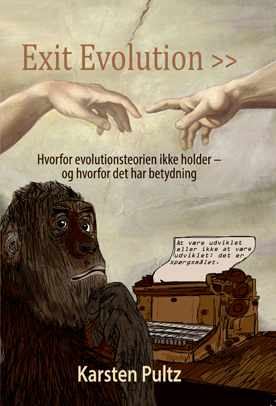 In the ongoing debate, university teacher Hans Henrik Hjermitslev, who has co-authored papers on creationism in Europe, provided a rather extensive piece about the growth of creationism. Hjermitslev,who has a Phd in the history of science, listed my book Exit Evolution as an example of the contemporary promotion of creationism.
In the ongoing debate, university teacher Hans Henrik Hjermitslev, who has co-authored papers on creationism in Europe, provided a rather extensive piece about the growth of creationism. Hjermitslev,who has a Phd in the history of science, listed my book Exit Evolution as an example of the contemporary promotion of creationism.
In his article Hjermitslev omits the fact that my book is a purely scientific critique of evolution, based on the books and scientific papers produced by Stephen Meyer, Michael Behe, Douglas Axe, Jonathan Wells etc. My book promotes ID, and I do not mix Bible verses in with the science or base any conclusions on the interpretation of the Bible. I have written several pieces in the newspaper I work for, criticizing creationism for its backward reasoning. It starts with the assumption that a certain interpretation of the Bible is true and then cherry-picks evidence to support this belief, instead of doing what I find more appropriate and satisfying, namely the ID approach. There, we look only at the empirical evidence approach and then draw the conclusions, while keeping religious and philosophical questions secondary and preferably in a separate sphere.
Despite the fact that I’ve publicly criticized creationism, Dr. Hjermitslev still defined my work as creationism. Of course, there is nothing new in that regard, it’s the good old trick of categorizing ID as creationism in order to avoid addressing the serious scientific issues it raises. It surprised me to even be mentioned by this academic expert. But maybe the Danish evolutionists are beginning to feel the hot breath from ID on their necks, and are therefore starting to launch preemptive strikes against ID proponents like myself.
What is slightly annoying is the fact that I’m being deprived of the opportunity to respond to the allegations raised against me by this university teacher. The Christian newspaper, Kristeligt Dagblad, simply refuses to air my side of the story. The journalist who manages the debate section chooses to ignore me. I sent him a piece in which I explain what ID is, and how it differs from creationism, for example, that ID considers only empirical evidence and that inference to the best explanation is valid for the ID hypothesis, just as it is for the theory of evolution.
My piece was, naturally, written in defense of pastor Mads Jakobsen but I also made the excuse for the bishop that she, hardly a villain, is just acting in accordance with what we all have learned in school, namely that evolution is a fact. She should not be blamed for the extremely biased way evolution is taught all the way from primary school to university. I got no answer from the journalist, no reaction, and no explanation, – I’m being met with complete silence. So what we have is a Christian newspaper which willingly airs unsubstantiated allegations against my work but at the same time refuses to bring my side of the story.
During the last few months there have been several articles in this Danish Christian newspaper which misrepresents the ID view in the most ignorant ways. In one article it was even defined as a belief in God-directed evolution. Both I and others from the Danish ID movement have tried to make the newspaper correct these errors, but we are being ignored. So the current state ID is facing in Denmark is that a Christian newspaper gangs up with the theological elite to heckle Darwin doubters and prevent an open debate about the validity of Darwin’s theory.
See also: Auto mechanic: Berra’s blunder splutters … yet again? Both the non-religious mechanic and the non-religious engineer found it immensely silly that anyone would suggest that the flagellar motor of the bacterium was the result of anything other than engineering. The second one added that the only question left was which engineering school God graduated from. (Karsten Pultz)
and
Theistic evolution: Conjuring up one’s own version of evolution and calling it God’s version. (Karsten Pultz)
Copyright © 2018 Uncommon Descent . This Feed is for personal non-commercial use only. If you are not reading this material in your news aggregator, the site you are looking at is guilty of copyright infringement UNLESS EXPLICIT PERMISSION OTHERWISE HAS BEEN GIVEN. Please contact legal@uncommondescent.com so we can take legal action immediately.
Plugin by Taragana
Michael J. Behe's Blog
- Michael J. Behe's profile
- 219 followers


